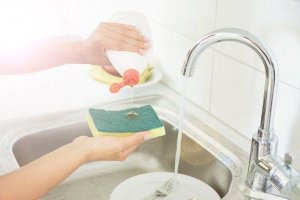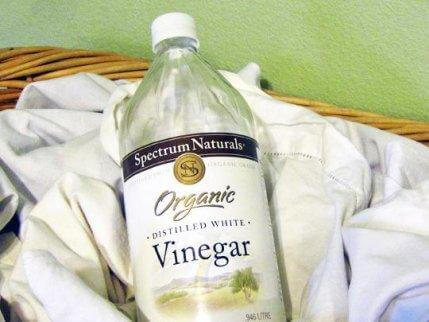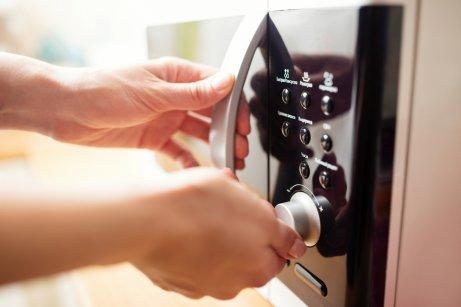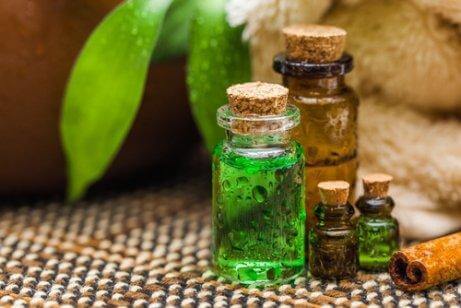Five Tricks to Disinfect Your Kitchen Sponges

Do you know why it’s important to disinfect your kitchen sponges regularly?
Kitchen sponges can become filled with harmful bacteria and microorganisms since they’re used to do so many cleaning chores. In fact, some studies have shown that sponges are one of the most contaminated home items, even more so than bathrooms.
Why is this?
Moisture and food waste in sponges create an environment conducive to the proliferation of many pathogens.
Therefore, it’s essential to learn different methods you can use to disinfect them, preferably after every use. In this article, discover five tricks to disinfect your kitchen sponges.
Why You Should Disinfect Your Kitchen Sponges
Kitchen sponges are used for washing dishes and other utensils. Due to what they’re made of, they easily release the fat and food waste that adhere to dishes.
They’re very dirty because the moisture and microcracks that make them up are perfect homes for bacteriasuch as E. coli., Salmonella, or Campylobacter, among others. They proliferate a lot faster in this environment and can survive for up to two weeks.
When you use them to wash dishes, many of these microorganisms can spread among different utensils, increasing the risk of infection.
Fortunately, all you have to do is replace them on a regular basis or use some formulas to keep them clean.
Make sure you read: The Hidden Dangers in Kitchen Sponges
Tricks to Disinfect Your Kitchen Sponges
Although kitchen sponge disinfection methods are quite useful, you still have to replace them about twice a month. While they may look good on the outside, they can harbor harmful waste and bacteria on the inside.
Here are five kitchen sponge disinfecting solutions.
1. White Vinegar

This product produces an acidic pH that favors the elimination of many bacteria and waste.
White vinegar is one of the best natural products to disinfect your kitchen sponges. Due to its concentration of organic acids, it alters the environment microorganisms need to proliferate. In addition, it eliminates odors and grease.
How to Use It
- First, boil a cup of water.
- Then, mix in a cup of white vinegar.
- After that, soak the sponge in the mixture for approximately 20 minutes.
- Wring it out to help remove dirt.
- If you consider it necessary, rinse it out with soap and water.
2. Liquid Dish Soap
Liquid dish soap can disinfect sponges due to its properties. However, for a deeper cleaning, it’s best to combine it with boiling water.
What to Do
- To begin, dissolve a tablespoon of liquid dish soap in a bowl of boiling water.
- Then, soak the sponge in the mixture (be careful not to burn yourself).
- After approximately 20 minutes, rinse and remove any waste.
3. Microwave

This appliance can be used to disinfect kitchen sponges due to the temperatures it reaches.
Microwaves help eliminate pathogens in kitchen sponges. High temperatures alter their characteristic moist environment, therefore preventing microorganisms from growing.
What to Do
- First, please note that some sponges are made from synthetic materials that may melt when exposed to high temperatures. Therefore, before using this method, it’s best to soak the kitchen sponge in a bowl containing water and vinegar.
- Then, put the bowl in the microwave for two minutes.
- If your sponge smelled bad or musty, this method will eliminate any odor instantly.
Be careful when you take the bowl out of the microwave, as you could burn yourself.
Discover: Six Ways to Clean and Disinfect the Sinks in Your Home
4. Lemon Juice
Although it isn’t the most powerful disinfectant, lemon juice is a good alternative when there are no other options. Lemon juice is a natural antibacterial agent that can help disinfect surfaces and elements.
Use it if you notice that your kitchen sponges are dirty or smelly.
What to Do
- Squeeze out the juice of several lemons and pour it in hot water.
- Next, soak your sponges in the mixture for 20 minutes.
- Then, rinse them with cold water and liquid soap.
5. Tea Tree Essential Oil

Due to its antimicrobial properties, tea tree can help control bacterial growth.
Although this ingredient is known for its therapeutic applications, it’s a great way to eliminate microorganisms on different surfaces. It can even eliminate bad odors.
What to Do
- First, add 15 to 20 drops of tea tree essential oil to a cup of boiling water.
- Soak the sponge in the mixture for 20 minutes.
- Then, rinse and wring it out to remove waste. If you notice that it still looks dirty, clean it with soap.
As you now know how important it is to disinfect your kitchen sponges, don’t hesitate to use one of the disinfection methods we mentioned in this article today!
All cited sources were thoroughly reviewed by our team to ensure their quality, reliability, currency, and validity. The bibliography of this article was considered reliable and of academic or scientific accuracy.
- Cardinale, M., Kaiser, D., Lueders, T., Schnell, S., & Egert, M. (2017). Microbiome analysis and confocal microscopy of used kitchen sponges reveal massive colonization by Acinetobacter, Moraxella and Chryseobacterium species. Scientific Reports. https://doi.org/10.1038/s41598-017-06055-9
- Erdogrul, Ö., & Erbilir, F. (2000). Microorganisms in Kitchen Sponges. Internet Journal of Food Safety.
- Wolde, T., & Bacha, K. (2016). Microbiological Safety of Kitchen Sponges Used in Food Establishments. International Journal of Food Science. https://doi.org/10.1155/2016/1659784
- Rossi, E. M., Scapin, D., Grando, W. F., & Tondo, E. C. (2012). Microbiological Contamination and Disinfection Procedures of Kitchen Sponges used in Food Services. Food and Nutrition Sciences. https://doi.org/10.4236/fns.2012.37129
- Speirs, J. P., Anderton, A., & Anderson, J. G. (1995). A study of the microbial content of the domestic kitchen. International Journal of Environmental Health Research. https://doi.org/10.1080/09603129509356839
This text is provided for informational purposes only and does not replace consultation with a professional. If in doubt, consult your specialist.








